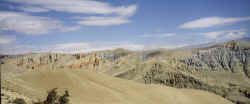MyHimalayasimpressions from |
|
|||||||
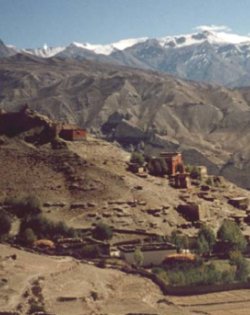
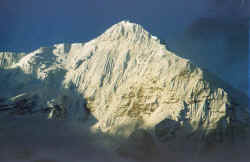
While the valley still lies in the shade, the first sunrays hit the vertical
north face of Nilgiri.
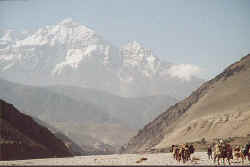
Walking in the riverbed would be fast, but looking for ammonites takes so time.
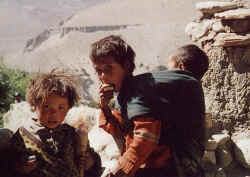
Curious children in Tangbe make waiting for lunch bearable.

Kids in Tangbe.
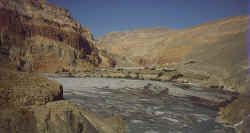
Chukang village lies on a fertile piece of land in a riverbend, facing the steep
organ-piped canyon.
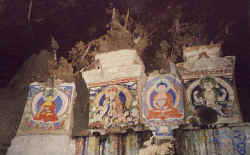
Off-the trail exploration of Rangchung Chörten, a cave monastery near Samar.
The fantastic climb into the gorge takes requires some effort, but it is worth
it.

Chorten above Geling on the way to Gemi: outstanding yet at the same time
blending in with its surroundings - this can be said of all architecture in
Mustang.
Our crew, Sirdar Bharat at the top left, kitchen crew in foreground, sherpas in
the middle and the toughest porters on the right.
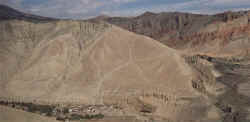
View from Gemi La, far down are the green fields of the village, to the right is
the long mani wall which we will pass tomorrow on the way to Tsarang.
Upper Mustang: Kagbeni - Chele - Gemi
Kagbeni - Chele - Gemi
Kagbeni - Tangbe – Chele
The day starts as beautiful as it ended yesterday, not a single cloud is on the sky when I get out of the tent.
Nilgiri glows orange while the first warm sunrays reach the fields. When we get up at most villagers are already up. Because of the heavy wind that blows dust and sand around from late morning until afternoon starting early is a good idea. Several routes lead to Lo Mantang, we take the west route, which means following the river on its eastern bank ‘till we reach the end of the broad valley. There we will cross the Kali Gandaki.
From Chele we will walk to Samar, Gemi, Tsarang and from there to Lo Manthang. This should take us four days. The way back will be a slightly different route, involving a detour to Muktinath. At least that’s the plan, bad weather or other circumstances could force us to change the itinerary.
Right after Kagbeni the trail climbs up, from here we have a nice view of the village, the valley and Nilgiri. Our horses take the faster way in the riverbed because they can cross the small streams. At first the path follows the river closely, later it leads eastwards to a flat piece of dry and desert-like land. The scenery is amazing, red sandstone pillars surprise me, I would have expected them in the Grand Canyon but not in the Himalayas. Thousands of years of erosion have formed the landscape; rock formations in fantastic forms and colours will be our companion during the whole trip.
The wind sets in just before we reach our lunch spot in Tangbe, a nice village which houses have been whitewashed and partly painted red recently. People are harvesting and carrying sheaves of barley to the courtyards where the grain is separated from the chaff with flails. It’s a relaxing atmosphere, the older people are nice but don’t pay much attention to us, the kids are very curious but relatively well-mannered. Older children go to school and have to help their parents, the younger ones take care of their even younger siblings but apart from that they have a lot of liberties.
On the other side of the river are caves high up in the vertical wall. Those served as housings in pre-historic times, only some have 'recently' been used as places for meditation. They are not accessible anymore which indicates that the river bed must have been much higher, but not much research has been done yet. A German archaeological project was started in 1992 to find out more about the caves and its inhabitants, I have to remember to find out more about it when I’m back home.
From here we can already see the camp site, Chele is a small white dot at the end of the canyon. The trail slowly descends to the riverbed, from here on it’s a easy walk. I take my time and walk slowly, this area is famous for its fossils and I do find quite a few. The wide valley seems to end abruptly at a vertical cliff. A bridge crosses the Kali Gandaki which flows through a natural tunnel in that cliff. The valley is getting narrower further north, some local people take this way to Lo Manthang when the water level is not too high. A steep trail takes us up to Chele, a small town with a nice view towards the Himalayan range. The north reveals nothing but hills and small mountains. Chele looks like the last village before a huge, impassable barrier after which comes nothing than a hostile wilderness.
The daily routine is almost the same each day: we get up at six, clear out our tent and wash before breakfast at seven, by eight we’re ready to leave. Some of the kitchen crew have already left by then, walking fast ahead of us because they need to get to the lunchspot early to prepare lunch. Each of us walks in his own speed, I’m usually ahead and wait on passes or at other nice spots. At noon we reach the lunch place where rice, vegetables and chapatis are almost ready. From here to the camp is just a short walk, seldom longer than two hours. The sun sets early, after dinner at seven it gets cooler and since I’m tired anyway it is normal to go to bed around nine.
Luckily Charles is a quiet tentmate but I rarely sleep through for a whole night. It is my daily dosis of four litres of tea and water that force me to get up at least once a night. Unfamiliar noises like howling jackals and barking dogs are much easier to get used to. In cloudless nights the stars areoverwhelming and make you forget the effort it takes to crawl out of the tent, put on warm clothes and shoes, search the toilet tent.
Chele – Rangchyung - Shyangboche
A steep climb has been announced for today and really, when we follow the trail westwards it goes up for quite awhile. When we see Ghyakar on the other side of a deep canyon the trail turns right, following the gorge. Running high above it the path is cut out of the rock and in good condition, which it needs to be considering that it goes down almost vertically for 150 feet. Walking is so much fun in such a landscape with good weather! After another hour I’m on a pass which offers a nice view towards Samar, the Kali Gandaki valley and the snow-capped mountains further away. Similar views will accompany me the following few days.
After lunch at Samar we have to cross a 'sidevalley', sounds idyllic but always turns into a hard walk. It means going from the top all the way down to the bottom, crossing a creek and then walking all the way up on the other side. We will encounter quite a few up‘s and down’s like these in the coming days. The group splits, some take the direct path to Shyangboche while I join the others who make a short detour to a cave monastery. We’ll never forget the term 'just around the corner' - when a Sherpa or Nepali says it get ready for a long and hard walk. It’s a tough but spectacular hike, after going up for a long time and sweating in the hot afternoon sun we stand above a deep gorge and follow the trail down to its bottom, which the sun probably never reaches. Although I’m afraid of heights when climbing towers I feel very comfortable here and am quite fast, but others take more time. Which is just fine, everybody should go at their own pace and it’s hard to imagine a place where waiting is more pleasant - resting in the sunshine in such a fantastic landscape is definitely not a waste of time.
We then walk up a sidevalley to the left for a few minutes and finally, two hours after leaving Samar, we’re there: the red-painted monastery seems glued to the vertical wall. Another steep climb and I’m in on of the holiest places in Mustang, Rangchyung Chörten. The name means 'the chorten that formed itself', because in the cave are big stalagmites which look like a chorten. Two great Buddhist teachers, Padmasambhava and Atisha, were staying in this cave centuries ago. Nobody lives here these days, but occasionally monks or lamas visit to meditate. No elaborate statues or paintings are displayed, nevertheless the atmosphere is very solemn. The only signs of people coming here are prayerflags glued to the ceiling and the small clay figures left behind by pilgrims.
It’s been a tough walk so far, especially if you consider that it is only our second day and we haven’t really had time to acclimatise and get in shape. Everybody is tired, but we still have to make it to Shyangboche before dusk. The trail goes through a forest of small trees and green bushes in the narrowing gorge. They grow here only because the vertical walls are really high and keep it cool and humid. Soon we reach a broadening valley where goatherds built walls in front of caves that serve temporary houses when they graze their cattle here. Nothing and nobody can be seen or heard, we’re the only ones.
Well, almost... suddenly there is a cloud of dust, movement and the sound of hoofs. We have scared up a group of half a dozen rare blue mountain sheep. Their speed and energy is incredible, a few seconds later they‘ve already disappeared behind the next hill. Considering the arid scenery the diversity of wildlife is surprising, apart from small mammals a variety of mountain goats, jackals, wolves and even snow leopards can be found here, but even the predators are extremely shy. Apart from two huge eagles which circled above Samar, the sheep and some lizards we won’t get to see any wild animals.
The way to Shyangboche seems endless, it’s an easy but constant climb and the destination is nowhere to be seen. Before we descended into the canyon Tenzing showed us where we camp, but it was so far away that we all thought he must be wrong. Turns out that he wasn’t. I’m about to reach my physical limit and my back is already hurting when three houses appear before us. Everybody is exhausted but has managed to make it there before it got dark. It was definitely too much for our liaison officer, the reserved man is so happy about getting here that he giggles all the time while praising his achievement and describing today’s hardship. He has problems with the altitude but doesn’t get seriously ill. This was the first and last time on this trek that he accompanies us on a little sidetrip. From now on he walks ahead of us with Sabita and Nima, much to the annoyance of the two. He is not exactly a motivator, he talks about altitude sickness all the time and how steep this and that part will be.
It’s much colder up here and soon after arriving I’m freezing. I don’t want to get sick so early on the trek, therefore I put on all my warm clothes, a woollen cap and take an overdose of Alcazyl. And since there’s a nice room in the 'guesthouse' it seems a good idea to spend the night here instead of sleeping in the cold tent. Unlike insect-infested guesthouses in other areas of Nepal this is a normal living room that’s just being rented to whoever wants to sleep here. While I’m dozing off the owner enters and lights a small butter lamp on the house altar.
Shyangboche - Gemi
Temperatures at night were not very low, but it is humid in the morning and although the tent is fine, a warm and clean guest-house is prefer-able. And it's also more cosy if you fall asleep while hearing people talk and laugh in the next room. Last evening I was afraid of getting sick, 8 hours of sleep later I feel as healthy as ever; no fatigue, no headache, no cold and even no sore muscles. Fortunately nobody else got sick either and all are in good mood. This comes as a nice surprise because not everybody looked very happy or healthy yesterday, in fact everybody was exhausted. Except for the Sherpas, who were making jokes about Westerners who pay a lot of money to do something as uncomfortable as trekking. But they realise that thanks to those trekkers they earn enough to make a decent living.
After 15 minutes walking we've already crossed the first of today's three passes, Yanda La, and pass a red-coloured chorten painted with the eight auspicious symbols. As yesterday, a deep valley and high mountains lie to our right-hand side while clouds gather in the mountain range to our left.
A terraced valley with groups of yellow trees lies in front of me. Above the village of Gelung stand two red gompas further. Unlike other villages where the houses are built close to each other and give the impression of a fortress, Gelung is widespread on a patch of green grass, thus giving the impression of an affluent community. Barren brown hills rise behind the village, the pass we have to cross is straight ahead and promises to be a nice climb. Yesterday's 'small detour to the gompa' is still in my mind, that’s why I decide to take it easy today and skip a tour of Gelung. We will be coming back the same way, I can look at Gelung in a few days. Therefore I set out for Nyi La, the way, although not as interesting as the gompas at Gelung, is pleasant. Two beautiful chortens are standing out and at the same time blending in with their surroundings, their form and natural colours make them just a part of the scenery.
Soon I catch up with the kitchen crew and am surprised about my speed. I rarely go hiking but I seem to be in great shape anyway, or maybe it's just the energy from the huge quantities of dal baht I eat everyday... We're not the only ones heading to Gemi, locals on foot and horse are on their way too. While resting at Yamjung, two houses just before the ascend, two women in beautiful traditional dresses pack two yaks. The two women pass me on the way up, shattering all my illusions about my speed... At first it seems that for once the climb is not rewarded with a great view: an endless sea of grey, red, yellow, black and white coloured hills stretch from here to the horizon. It is breathtaking, but it takes a few moments to catch and process the vast arid, barren wilderness. It is desolate and beautiful at the same time, but it is not the kind of beauty we are used to.
The path is slowly going down towards the last pass for today, Gemi La. As usually, I add a stone to the pile on the pass muttering 'soso' - good luck - and sit down to enjoy the view for a few minutes. The red cliffs just behind seemed so far away this morning, and now after just a few hours we‘re almost there. I wonder when and why the dilapidated village further downstream has been abandoned, was it just one year ago or one-hundred years? It makes me realise how unforgivable nature is, once the springs or glacier water run dry people have to move and villages are doomed to be deserted.
The landscape is so rugged that it looks as if it was formed by somebody playing around with clay and stones in a sandbox. A deep riverbed winds itself down from the red cliffs, straight ahead are hills with the colour and shape of huge dunes. Another wide valley is coming from the left-hand side and in the middle of it all lies Gemi, built high above the river, surrounded by fields.
A camera just can’t catch the magic of moments like this. You can only try to memorise it accurately; the landscape, the smells, the sun, the wind, the feelings of happiness. I stroll through the fields towards Gemi, harvest season is over and only a few farmers are ploughing the fields. Despite its size - Gemi is the third largest town in Mustang - it is very quiet, but maybe that is simply because it is so early. It's just after noon and I'm far ahead of the group, luckily I see the cook sitting on a roof and don't have to wander around looking for them. After a tour around town I discover a haystack on top of a roof, overlooking the valley and village and definitely the best spot for a nap. The view over the village is interesting, it's the first town where there is dung on the roofs to dry in the sun. It burns well and – thanks to the altitude – doesn’t smell too bad. In winter it is used as fuel, since due to climatic changes and deforestation wood has become scarce and expensive. A Japanese project is planting apple trees and trying to bring environmental awareness and sensible sources of income to these villages.
After lunch I wash myself in the village fountain for the first time in three days - a minor attraction! Old women and children are watching, a kid wants some soap but three portions of soap are not enough to get his hands clean. Considering the cold of the water I wouldn't wash very often either if I lived up here.
Gemi is an interesting town to explore. Unfortunately the dzong is crumbling down and seems to be used only as a storage room these days. The Sakya gompa near the fort is closed, but after a few knocks on the door a monk asks me to step in. He speaks only little English and my knowledge of Tibetan comes from the 'LonelyPlanet phrasebook' but we communicate fairly well and manage to talk about Mustang, Switzerland, the Dalai Lama, and me. My answer to the question 'who is your lama' is rather embarrassing: 'I don't have one'. Though this seems strange to him, he stays very friendly and shows me around. The new paintings in the assembly hall are not too interesting, the older ones are far more impressive. He explains that tomorrow will be a festival for Mahakala, one of the eight Dharmapalas – the protector deities of Buddhism. Half a dozen monks on the balcony above the courtyard are busy making tormas. These small yak butter figures serve as offerings. It's incredible how colourful and detailed they are. One older monk forms pedestals out of tsampa, grounded barley which used to be a staple food. Even though I'm an outsider I don't feel like a stupid spectator or tourist and watch them for quite awhile. I'm offered butter tea and something to eat but I decline politely. I doubt that my stomach is ready to handle real butter tea yet. Two laymen leave the monastery and stop at houses to give people sausages and butter or cheese. I should have taken a few lessons of Tibetan so I could ask about customs and things I don’t understand.
After dinner the local dance group asks if we want to see some dances, the donation is being used for 'road maintenance' and village cleanings. At first it feels a bit awkward; dumb tourists watching artificially kept-alive culture. But the uncomfortable feeling disappears quickly, the women seem to enjoy themselves and quite a number of villagers are also watching. Especially the kids show a great interest and have a lot fun when they see us dancing, or better... trying to dance. After four dances the dancefloor is open for everybody, some undiscovered talents are in our kitchen crew (their singing and dancing is great), but the best dancer is a very pretty Tibetan girl who works for the Japanese project. Needless to say, we don't do too well in the dancing. Our canon 'frèrè Jaques' gets more applause, the 'Buurebüebli' is even quite a success.
I usually never drink alcohol, so after a few sips of rakshi - hard liquor made out of wheat which tastes delicious - I imagine to fall asleep even faster than usual.
|
Summary Part 2:
After enjoying fantastic sunrise on Nilgiri we continue along the bank of the Kali Gandaki. The desolation and barren plateaus are fascinating, the village of Tangbe is equally picturesque. At Chele we leave the river behind and climb up to Samar. Several small passes offer great views, especially the sight aprroaching Gemi is breath-taking. The village offers plenty of opportunities for exploration and the chance to taste local drinks. |
